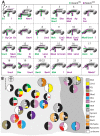Transcription factor expression uniquely identifies most postembryonic neuronal lineages in the Drosophila thoracic central nervous system
- PMID: 24550109
- PMCID: PMC3929408
- DOI: 10.1242/dev.102178
Transcription factor expression uniquely identifies most postembryonic neuronal lineages in the Drosophila thoracic central nervous system
Abstract
Most neurons of the adult Drosophila ventral nerve cord arise from a burst of neurogenesis during the third larval instar stage. Most of this growth occurs in thoracic neuromeres, which contain 25 individually identifiable postembryonic neuronal lineages. Initially, each lineage consists of two hemilineages--'A' (Notch(On)) and 'B' (Notch(Off))--that exhibit distinct axonal trajectories or fates. No reliable method presently exists to identify these lineages or hemilineages unambiguously other than labor-intensive lineage-tracing methods. By combining mosaic analysis with a repressible cell marker (MARCM) analysis with gene expression studies, we constructed a gene expression map that enables the rapid, unambiguous identification of 23 of the 25 postembryonic lineages based on the expression of 15 transcription factors. Pilot genetic studies reveal that these transcription factors regulate the specification and differentiation of postembryonic neurons: for example, Nkx6 is necessary and sufficient to direct axonal pathway selection in lineage 3. The gene expression map thus provides a descriptive foundation for the genetic and molecular dissection of adult-specific neurogenesis and identifies many transcription factors that are likely to regulate the development and differentiation of discrete subsets of postembryonic neurons.
Keywords: Adult neurogenesis; Drosophila; Gene expression map; Hb9.
Figures








References
-
- Betschinger J., Knoblich J. A. (2004). Dare to be different: asymmetric cell division in Drosophila, C. elegans and vertebrates. Curr. Biol. 14, R674–R685 - PubMed
-
- Bossing T., Udolph G., Doe C. Q., Technau G. M. (1996). The embryonic central nervous system lineages of Drosophila melanogaster. I. Neuroblast lineages derived from the ventral half of the neuroectoderm. Dev. Biol. 179, 41–64 - PubMed
-
- Brand A. H., Perrimon N. (1993). Targeted gene expression as a means of altering cell fates and generating dominant phenotypes. Development 118, 401–415 - PubMed
-
- Britton J. S., Edgar B. A. (1998). Environmental control of the cell cycle in Drosophila: nutrition activates mitotic and endoreplicative cells by distinct mechanisms. Development 125, 2149–2158 - PubMed
-
- Broihier H. T., Skeath J. B. (2002). Drosophila homeodomain protein dHb9 directs neuronal fate via crossrepressive and cell-nonautonomous mechanisms. Neuron 35, 39–50 - PubMed
Publication types
MeSH terms
Substances
Grants and funding
LinkOut - more resources
Full Text Sources
Other Literature Sources
Molecular Biology Databases

